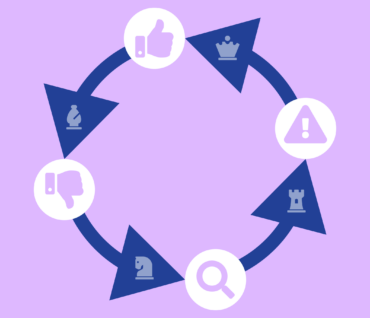
Get Started
Graphite's supplier management tool helps you onboard faster, cut time on risk reviews and streamline supplier validations. Save time and money.
October 26 2023
Why Supplier Experience Management is Important
How the procurement industry is shifting toward supplier experience management, and how you can ensure your business succeeds in this new era.
In an industry historically run by customers, the tides for procurement are changing. As supply chains become more constrained, businesses are vying to be the customers of choice. What does this mean for your business? As procurement becomes supplier-centric, you must rethink strategies to win your desired suppliers.
Don’t want to get left behind? It’s time to change how you think about your business’s suppliers, start listening to their needs, and actively put supplier experience management in place.
Why Supplier Experience is as Important as Customer Experience
With new government regulations, risk considerations, and factors such as sustainability–not to mention restricted supply chains–gaining business from suppliers is not what it once was.
Supplier experience management (SXM) will matter in becoming a company suppliers love to work with. Still, current procurement “best practices” often focus on the customer, leaving suppliers to jump through hoops to make relationships work. In the new age of procurement, these practices won’t hold up.
It’s time to change the way you do things. Here are a few places you could start.
Revamp your supplier onboarding and management portal
The supplier portal is a pain point often overlooked by buyers. Most of these systems consider suppliers’ needs last, if at all. In the past, it was assumed that if suppliers wanted the business, they’d do whatever it took to get it, no matter the inconvenience to themselves.
In today’s competitive climate, it’s too easy for a supplier to find business elsewhere if your supplier experience management is clunky, difficult, or outdated. Take the time to review your supplier onboarding process yourself– is the experience good? Or, more likely, is it frustrating or confusing? Now imagine the job of a supplier– with hundreds of these portals to work with daily. Do you want to have their business? Think about supplier experience management and find ways to make their lives easier.
One possible solution would be a supplier portal that helps suppliers easily share and update their information. A secure LinkedIn-like solution for suppliers, where they can decide what to share and with whom. This kind of system can serve as a central location where suppliers enter their information just once for all their customers and then simply update it as needed.
For you, this shift will mean no more documents and spreadsheets delivered through email and outdated so frequently that you can’t keep up. No more searching through databases for the information you need. No more back and forth over what information is required. For suppliers, a standardized portal would mean an end to managing disparate platforms for every customer they take on.
Does that sound too good to be true? This is the way procurement systems are shfiting.. And, with the tides turning toward the supplier, doing so will soon become essential.
Get Requests out of Excel and into a Supplier Management Platform
Too many buyers still send out requests for information through email and Excel. Businesses cannot afford to stay in the technological dark ages. Other options will attract suppliers to your business and better the working relationship for both parties.
Working with RFXs housed in Excel is unacceptable at this point. The lack of collaboration means most work must be done over email– busy work that no one needs or wants, especially suppliers working with hundreds of clients.
Not to mention that this requires suppliers to double their work hundreds of times over. Many of these RFXs will be nearly identical, but in Excel, suppliers will have to fill out each individually, often answering the same questions hundreds of times.
This might be common in the industry but is no longer acceptable. Suppliers will undoubtedly look elsewhere when they learn they will be doubling their work to get your business.
Make Supplier Information Management a Priority
Currently, too much supplier information is outdated and inaccessible. Often, a central place for all supplier data hardly exists. This makes finding what you need quickly and being confident in its accuracy nearly impossible.
Return to the idea of a supplier portal that works more like a private LinkedIn. This functionality would mean suppliers never have to enter their information into another portal again. Keeping data updated will be instantaneous.
Better ways to manage supplier information will be key to gaining their business. Suppliers won’t want to work with a business that asks for the same information, can’t find previous information, or holds on to outdated information. Your supplier information needs to be organized, updated, and quickly accessible.
Promote Supplier Collaboration and Relationship Building
Another big issue with current systems is the lack of collaboration. Excel and many supplier portals have no functionality for easy collaboration or sharing of information. For the relationship to feel easy and seamless, collaboration is essential. So upgrading to a system that allows for collaboration and easy sharing will matter a lot to your suppliers.
Suppliers want to be partners with you, but this becomes impossible without easy collaboration. A shift to greater openness to suggestions will start with your business. You need to consider every supplier as a partner rather than a checkbox. Sure, they can do their job the way you tell them to, but if that is all you expect, you’ll miss out on the best suppliers who bring fresh and efficient ideas of their own.
In the new supplier-centric climate, your business must understand that the best suppliers want to work as partners. Active supplier experience management means that you’ll need to update your practices for collaboration and communication. A renewed focus on supplier experience management may take more effort in the short term, but it will pay dividends in the long term.
How can you put supplier experience management in place?
Ready for a supplier-centric solution to these issues? Want supplier experience management to be a part of your processes? Graphite Connect’s portal allows suppliers to enter their data once and securely share it with customers. Your suppliers aren’t yet on Graphite? No problem. Ask them to set up their profile, and they can input their information for you once, update it at will, and use that profile with other customers.
You can access supplier data and request anything you’d usually send in an RFX through Graphite’s questionnaire capabilities and store that data in a central location that is quickly accessible for both parties.
Graphite can also help you simplify supplier intake, onboard new suppliers, and even keep track of key success metrics.
Ready to Learn More?
Graphite exists to streamline intake, accelerate onboarding, and improve data management, all while improving your suppliers’ experience.
Request a Demo




